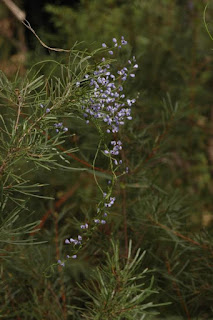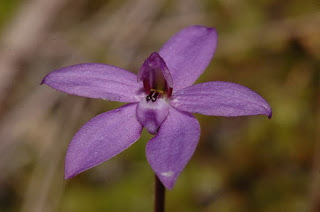For many months, since reading Benj Whitworth's postings on the Canberra Ornithologists Group forum about the joys of discovering the plants and birds of Ulladulla, I have wanted to explore the Reserves there.
My friend Kirsten, who grew up in that area, kindly showed me around several of the Reserves there, yesterday.
There are several excellent Reserves at Ulladulla (on the coast 45 minutes driving time, south from Nowra).
Having done a considerable circuit at the Wildflower Reserve, we adjourned (via the excellent Hayden's Pies) to the South Pacific Heathland Reserve, This is just along Dowling Street, behind the Ex-Servicemen's Club which is on the Pacific Highway, on the southern end of Ulladulla. (see linked map for both Reserve locations)
The first place we visited is known as the Wildflower Reserve. At first it seemed to be a fairly uninviting patch of coastal forest. Kirsten will kill me for that comment. But there were many interesting plants there, especially leaves of Acianthus, Corybas and the related Nemacianthus - all tiny Ground Orchids - (upon close examination of the forest floor).
We saw lots of birds, most especially a mixed feeding flock of Silvereyes, Brown Thornbills and Wrens, with Pardalotes and Yellow-faced Honeyeaters in the canopy above, in the Wildflower Reserve.
We saw lots of birds, most especially a mixed feeding flock of Silvereyes, Brown Thornbills and Wrens, with Pardalotes and Yellow-faced Honeyeaters in the canopy above, in the Wildflower Reserve.
Kirsten photographing a very thin-leaved Acacia.
It is possibly Acacia elongata (but I am no Acacia expert)
 |
| Acacia elongata (possibly) |
Click to see the ribbed stems and 3 flowers coming from each leaf axil.
That species (A. elongata) looks right to me.
This was an unexpected bonus.
Waxlip Orchid - Glossodia major
That species (A. elongata) looks right to me.
 |
| Compare this image from the Bega Valley area. |
 |
| Sprays of Comesperma volubile were draped over many shrubs |
This was an unexpected bonus.
Waxlip Orchid - Glossodia major
 | |
| Glossodia major just opening up. |
Believe it or not, this was what I had been hoping to see.
Well, hopefully a fresh flower - but this dried flower is still identifiable
because of the long filamentous tips on the sepals.
It is the Mayfly Orchid, Nemacianthus caudatus
 |
| Long filamentous tips on the sepals of Nemacianthius caudatus are still evident. |
One of the identifying features, apart from the long sepals,
is the brilliant red underleaf.
 |
| Underleaf of Nemacianthus caudatus |
But there were hundreds of birds in the South Pacific Heathland Reserve too.
Yellow-tailed Black Cockatoos.
They love the Casuarinas and Banksias in the Heathland Reserve .
 |
| Head of Black Cockatoo seen on top of low Casuarina bushes |
 |
| New Holland Honeyeaters (3) in Casuarina above Grevillea bush. |
And now to some of the more obvious flowers
from the wonderful South Pacific Heathland Reserve.
These Correa reflexa plants were prominent in this Reserve.
The flowers were very fat (I think so anyway).
Possibly Correa reflexa var speciosa?
This is the very pretty (but small) flower of Eucalyptus sieberi
It is known as the Silver-top Ash.
 |
| Pimelea linifolia |
A young flower head of the NSW Waratah (Telopea speciosissima)
 |
| Telopea speciosissima |
The sweet honey-smell of the Wedding Bush
was almost overwhelming in places where these plants were growing.
 | |
| Ricinocarpos pinifolius |
Further to our finding the large Waxlip Orchid in the first reserve
in a moss bed in the Heathland Reserve we found a colony of
the Small Waxlip Orchid Glossodia minor
Click on the image to see the diagnostic dark double "calli"
on the labellum.
Here is a loose colony
on a moss bed.
If you expand the image (click)
you will see the flat hairy leaves of these plants.
 |
| Glossodia minor in a moss bed |
Here is a local favourite at Ulladulla - the rare Grevillea macleayana
It was previously known as Grevillea barklyana subsp. macleayana
It is referred to by PlantNET as the Jervis Bay Grevillea.
It has the classic "Toothbrush Grevillea" flower structure.
 | |
| Grevillea macleayana |
Probably my favourite image of Grevillea macleayana.
It shows why it is so popular with the local Honeyeaters and Wattlebirds.
There is a lrge bead of nectar which has leaked out from the flower.
It shows how rich these plants are in nectar.
 |
| A bead of nectar visible in the flower of Grevillea macleayana |
Here is one of the surprises of our trip
Lyperanthus suaveolens - the so-called "Brown Beaks" Orchid.
 |
| Close-up of Lyperanthus suaveolens |
 |
| Full stem of Lyperanthus suaveolens |
Pigeonhouse Mountain
Whenever I glimpse this mountain (always in the distance)
I am reminded that it was named by Captain James Cook in 1770.
A symbol of our earliest European conquest (and place naming).
My good friend James, believe it ought be called Nipple Mountain.
I wrote that before I checked for the Aboriginal name.
"Didhol or Dithol" which means
Woman's Breast on account
of the distinctive shape of the mountain.
(according to Wikipedia)
I wrote that before I checked for the Aboriginal name.
"Didhol or Dithol" which means
Woman's Breast on account
of the distinctive shape of the mountain.
(according to Wikipedia)
 |
| Pigeonhouse Mountain in the distant hinterland behind Ulladulla. |





5 comments:
Thanks so much for another great post full of fantastic photos of our lovely native orchids.
Thanks Lyndell
Glad you liked it. This one is a bit longer than normal, with a wider range of species.
Cheers
Denis
Obviously a great trip giving great photos! Well done.
Martin
Hi Martin
The heathland Reserve , in particular was very pretty - a real wildflower display. I thoroughly recommend it, if ever you find yourself on the coast.
These days I find the challenge of having the right lens available a problem. To get the wide shots I would need to juggle lenses. So most of these were taken with the macro, which has a narrow field of view. Even the Pigeonhouse shot was taken with the macro, which is sort of ironic.
Kirsten has sent me the following comment:
"Just goes to show that the Ulladulla/Jervis Bay region is a treasure trove of species waiting to have their distribution significantly increased.
(Also) because they are at the southern or northern end of their distribution (local forms) are (often) quite distinct from their their description from their type species at the Herbarium.
A true botanists delight.
Kirsten
DJW Reply: I know what you mean. We have the same issue here in Robertson. Many species here are on their northern or southern limits of their range.
Post a Comment